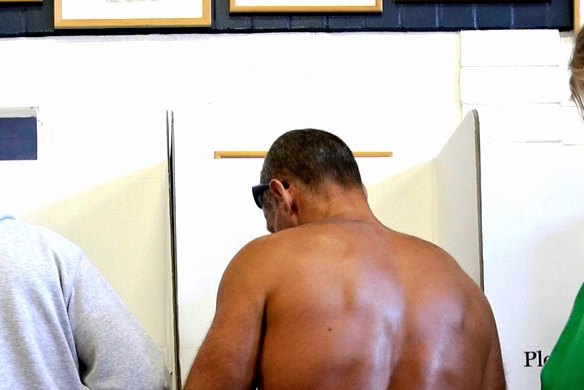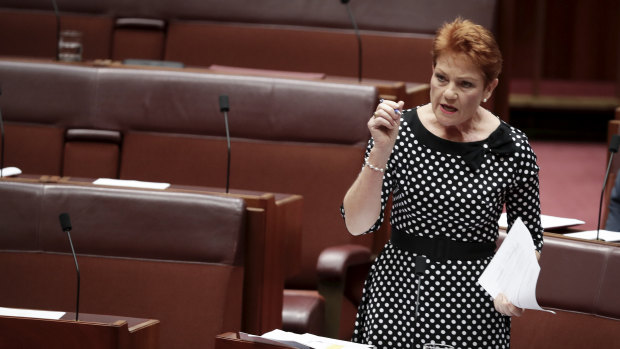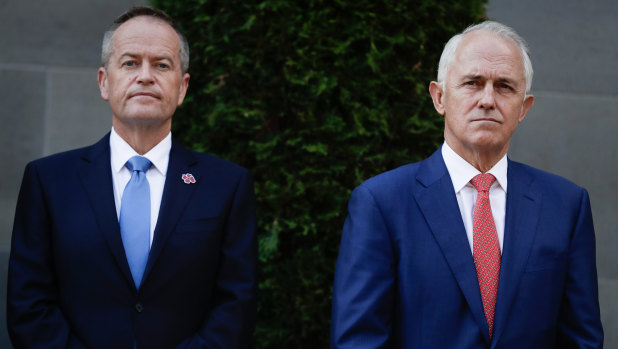- Exclusive
- Politics
- Federal
- Political leadership
This was published 6 years ago
The fundamental operating model of Australian politics is breaking down
By Lachlan Harris & Andrew Charlton
Is there any Australian left who hasn’t complained, or at least rolled their eyes about the state of politics in Canberra? Most of us tend to blame the politicians for all this, but a new analysis of voter data suggests a less comfortable truth. The problem is not just them. It’s also us.
- See where you fit in: take the questions from the Australian Electoral Survey
- Do you think politics is broken? Send us your responses
The fundamental operating model of Australian politics is breaking down. The data, from the Australian Election Study (AES), reveals the dramatic polarisation of Australian politics over the last two decades. In 1996 more than one in three Australian politicians (37 per cent) rated themselves as “moderate” – that is, centre-left Liberal and centre-right Labor politicians. This share has shrunk dramatically. At the most recent federal election in 2016 only one in 10 politicians described themselves as moderate.
The AES looks at long-term trends in federal elections. It is a massive source of data, with more than 100 questions put to thousands of voters and hundreds of candidates at every election since 1987. The survey, run by the Australian National University’s School of Politics and International Relations lifts the lid on many of the deep issues in our political system that can’t be seen in fortnightly polls or snap surveys.
Polar opposites
The ideological drift towards the extremes of the political landscape that the AES details is one of the causes of Australia’s broken politics. Getting legislation through the senate – and through the House in these times of minority and bare-majority governments – requires broad, often cross-party, support. That support is easier to build when there is a critical mass of centrists in both parties who can compromise and negotiate across the aisle, with shared values as common ground. Fewer centrists makes serious reforms harder to get across the line. An obvious example is climate change policy, where the polarisation of politics has made meaningful reform difficult for years.
The AES data shows an unprecedented level of anger and frustration directed towards our politicians. More than half of all voters think politicians are out of touch – a record high in the survey’s history. Only a quarter them believe our elected leaders are doing the right thing – another all-time low.
But what if our politicians are simply mirroring what they are picking up from the community? They are, after all, “representatives”, chosen from communities across the country, and their professional success depends on responding to voters’ concerns. And voters, too, are becoming more ideologically polarised. In 1993, 54 per cent of voters surveyed by the AES described themselves as centrist. By 2016 that number had fallen to just 42 per cent. This data proves that Australian political polarisation is not just limited to the political class. In fact, we cannot understand the polarisation in Canberra without reflecting on the polarisation in our communities.
The effects of polarisation can be seen in the rising support for increasingly ideological minor parties such as the Greens, One Nation and the Australian Conservatives. The growth of minor party support has been well documented, but the AES data shows something new: the minor party vote has changed in quality as well as number. In 1990 less than half of all minor party voters said they “strongly support” the party they voted for. In the most recent election this had shot up to two-thirds.
Remember the Democrats’ commitment to “Keeping the Bastards Honest”? Votes for minor parties were once called “protest votes”. That’s not the case anymore, or at least not nearly so much. As the electorate becomes more ideological, those votes are being cast as firm votes for minor parties, not against the major ones.
Many commentators have suggested that political disillusionment is driven by discrete groups, like working-class men or lower-income families. The AES data supports this, but only up to a point. It’s true that 37 per cent of unskilled men are dissatisfied with politics (a record high), but dissatisfaction among the rest of the population is even higher, at 40 per cent. It’s true that minor parties are now attracting one in four lower-income voters, but they are also winning almost exactly the same share of higher-income voters.

People cast their vote at Bondi for the 2016 federal election.Credit: Edwina Pickles
The breadth of political polarisation across the community suggests that its causes are deep and longstanding. People used to watch the same nightly news programs, read the same articles in a handful of newspapers. Many listened to a pastor or priest each Sunday, were members of unions, service clubs and community organisations. These forces bound the community together and helped normalise people’s views and political ideas. Not everyone had the same opinions, but there was common information from which to conduct a productive debate. Whether left, right, working class, middle class, religious or atheist, people were still hewed to common sources of information and shared values.
In the 21st century, these binding forces have weakened and voters have become more disparate. Fewer people are members of churches, unions, service and community groups. Rather than watching the evening news on TV, many Australians now get most of their news through personalised social media feeds, which can reinforce group-think among ever-more partisan communities.
The internet is the new political battleground. Political differences are being exploited by organisations that target individuals using data from Facebook, Twitter and massive email databases. Rather than prosecuting a single public manifesto, political warfare now involves personalised messages directed at the known fears and prejudices of individual voters with unprecedented precision.
Broken system
The political implications of increasing voter polarisation are profound: the fundamental operating model of Australian politics is breaking down. That operating model was based on the “median voter principle”, which assumes that the electorate is a continuum from conservatives on one side to progressives on the other. The combination of compulsory voting and a two-party system meant that the strategy to win the most votes in Australian politics was always to position your party as close to the median voter as possible.
As the electorate becomes more divided, this operating model isn’t working nearly as smoothly as it once did. More ideological voters don’t want centrist compromise, which is why they keep rewarding parties that decry it. In recent years the political groups that have most successfully navigated these dynamics have been the populist fringe or single-issue parties – Pauline Hanson’s One Nation, regional independents, the Greens, and for a time Nick Xenophon, and Clive Palmer (for an even shorter time).

Pauline Hanson in the Senate. The political groups that have most successfully navigated these dynamics have been the populist fringe or single-issue parties.Credit: Alex Ellinghausen
Their political MO is to exploit the growing ideological divide, cultivate rivalries between communities and appeal to disparate voters. These individual parties tend to scale up fast, and then combust just as quickly, but the long-term trend of a rising minor party vote outlives them all.
If you think the recent results in the South Australian State election signal a reversal of this trend, think again. Xenophon’s vote didn’t live up to a preposterous set of (self-imposed)
expectations, but the minor party lower house primary vote was still at a record high of 28.7 per cent, and the matching major party vote a record low of 71.3 per cent. That means in the four years leading up to the 2018 SA election, one in every 10 lower house voters shifted from the majors to the minors. Almost exactly the same proportion of voters made the same shift in the two years leading up to the 2017 Queensland state election. A 10 per cent swing in two state elections is a landslide in anyone's language.
There are occasional flashes of good news for the majors, like the recent strong showing in Tasmanian state election, but for the most part the majors have struggled to adapt. They are leaking votes to minor parties and facing an internal power shift from centrist factions to hard-line activists.
Most of our politicians seem clueless as to how to respond. Many of them cut their teeth in the heyday of the two-party system and struggle to imagine any alternative. They hope that by cycling through leaders, they will eventually find an individual with enough mass appeal – another Hawkie! – to lead them get back to “politics as usual”.
This strategy misdiagnoses the problem. There will be no return to politics as normal. The ideological polarisation of voters is a longstanding and global trend. In almost every part of the world, populists are overturning establishment politics with ideological rhetoric and incendiary manifestos. Donald Trump and Bernie Sanders in the US, Nigel Farage and Jeremy Corbyn in the UK, Italy’s Five Star Movement, Alternative for Germany and other populist parties have secured staggering growth in their support bases, and many have snatched political victories that would have been unthinkable just a few years ago.
Survival tactics
To survive in an increasingly ideological and disparate electorate, major parties will need to adopt a more aggressive policy agenda. In the old paradigm, Australian elections were won by capturing precious inches of the political centre ground and successful leaders pursued moderate, low-risk policy agendas. But “small target” policy agendas will struggle to compete in a more ideological environment. Major parties will need to focus on presenting and delivering significant, structural reforms. If they are not willing, or not able, to take political risks and occasionally pick political fights, they simply won’t be heard.

The major parties will need to adopt a more aggressive policy agenda to survive. Credit: Alex Ellinghausen
Major political parties will also need to adapt their structures. Over the last quarter century, they have allowed their membership to dwindle and their organisational wings to succumb to hyper-centralised control, opaque preselections, divvying out of political favours and dubious donations. In an increasingly ideological world, major parties can’t rely on compulsory voting to bring out their supporters. They will need to re-build their structures in ways that build respect, trust, authenticity, conviction and participation.
Whoever they vote for, people will also have to adjust the way they assess and reward politicians if they want our national parliament to function more effectively. Rather than reward absolutism, voters will need to reward politicians, and political parties, who can cooperate and achieve agreement across political battle lines. This will be a major adjustment for many voters steeped in the tribalism of post-war Australian politics.
The AES data confirms the parlous state of Australian democracy. While it’s easy to blame politicians, the data also shows that the cause of our democratic disease is both more complicated and more permanent than previously thought. Voters have changed faster than the political system, and the centrist two-party system doesn’t accommodate the new ideological divide.
If Australia’s major political parties want to stem their decline, they will need to adapt to an increasingly polarised and ideological electorate. And if Australian voters want to understand why our democracy seems so broken, they should start by looking in the mirror.
Andrew Charlton is the author of Ozonomics and Fair Trade for All (with Joseph Stiglitz) and two Quarterly Essays, "Man-Made World" and "Dragon’s Tail". He is a co-founder of the strategic advisory business AlphaBeta. Lachlan Harris is the founder and CEO of RevTech Media. Both worked for former prime minister Kevin Rudd.